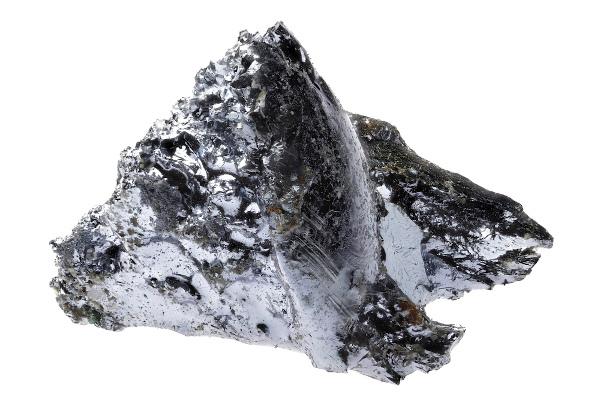THE osmium, atomic number 76, is a bluish-white metal belonging to group 8 of the Periodic Table. It is also considered a Platinum Group Metal (MGP), along with platinum itself, in addition to palladium, ruthenium, iridium and rhodium. Among the metals, osmium has the highest density. Its chemical properties are similar to that of ruthenium, another group 8 element and also an MGP.
osmium is the rarest stable element Earth's crust and, because of this, its production and uses are very limited. Even so, osmium can be used as a metal alloy improver, as well as in the production of fountain pen tips. The OsO4, osmium tetroxide, is widely used as a contrast in microscopes, in the detection of fingerprints and as a catalyst.
Read too:Francium — the second rarest chemical element on the planet
osmium summary
osmium is a metal group 8 of the Periodic Table of bluish-white color.
It is considered a Platinum Group Metal.
Among the metals, it has the highest density.
Its chemical properties are similar to that of ruthenium, the element above Periodic table.
It is the rarest element in the earth's crust, and therefore its production is very small.
It is used as an improver for metal alloys, in addition to being used in the production of fountain pens nibs.
It was discovered by Smithson Tennant, an English chemist.
osmium properties
Symbol: You.
Atomic number: 76.
Atomic mass: 190.23 c.u.
Electronegativity: 2,2.
Fusion point: 3033°C.
Boiling point: 5012°C.
Density: 22.587 g.cm-3 (at 20°C).
Electronic configuration: [Xe] 6s2 4f14 5d6.
Chemical Series: group 8, transition metals, platinum group metals.
osmium characteristics

osmium is a shiny metal, bluish-white in color, quite hard and brittle, even at high temperatures. It belongs to the group called Platinum Group Metals (MGP), along with palladium, iridium, rhodium, ruthenium and platinum. Among the MGPs, it has the highest melting point and the lowest vapor pressure.
The element osmium is recognized for being the densest metal, although for some authors iridium occupies this position. This is because the densities of both metals differ by only 0.1% at a temperature of 20 °C. Osmium is also the rarest stable element in the entire earth's crust, with a concentration of just 1 gram per 200 tons.
In its metallic form, osmium strongly resists high levels of compression, to a degree comparable to that of diamond. In the form of substances, osmium is capable of presenting 11 possible oxidation states, ranging from -2 to +8, with states +3, +4, +6 and +8 being the most common.
Osmium tetroxide, OsO4, is, together with ruthenium tetroxide, RuO4, the compound in which an element has the highest formal charge in the Periodic Table (+8). This oxide is quite toxic and also volatile, with a boiling point of 130 °C.
Chemically, osmium very reminiscent of ruthenium, also a member of group 8 and also an MGP. For example, osmium slowly reacts with the gas oxygen at room temperature. On the other hand, it reacts with gas chlorine and gas fluorine at room temperature, in addition to being attacked by hydrochloric acid mixed with oxidizing agents and also by molten alkalis.
In nature, seven isotopes of osmium can be found, with one, the 186Os, is radioactive, with an extended half life. Another 34 isomers are known, all synthetic and radioactive.
Check out our podcast: Hard as a diamond: what does it mean?
Where can osmium be found?
The main natural source of osmium is osmiridium mineral (or iridosmine), a natural alloy between osmium and iridium in which the composition of the former varies from 15 to 40% by mass while that of the second varies from 80 to 50% by mass.
However, as an MGP, osmium can also appear associated with platinum, as in the regions of the Ural Mountains and North and South America. It can also be found at some nickel ores, as in the city of Sudbury, province of Ontario, Canada.
Obtaining osmium is very difficult, and its production is very small, in the range of 500 kilograms per year. despite the difficult to manufacture, metallic osmium powder can be synthesized in an atmosphere of hydrogen at a temperature of 2000 °C.
osmium applications
Despite the small production, osmium can be applied in production of metal alloys of extreme hardness. Iridium-osmium alloy can be applied to the tip of fountain pens.

The OsO4 is the most useful compound of osmium. It is a colorless solid, but can be used as microscope contrast (improving visualization) and also how fingerprint detector. It can also be used as catalyst in the pharmaceutical industry, in the production of drugs for obesity and diabetes, for example.
These catalytic processes are based on the work of Barry Sharpless, laureate of the Nobel Prize 2001, which used OsO4 as a key component in a catalyst mixture to add two hydroxyl groups to a carbon-carbon double bond.
osmium history
the osmium was discovered by the English chemist Smithson Tennant. In 1800, Tennant set up an enterprise for the commercialization of platinum, starting to produce large samples of this metal. He realized, as had others before him, that extracting platinum from its raw ore with aqua regia generated a black insoluble residue.
In 1804, he announced that he had isolated two new metals: iridium and osmium.. The word osmium comes from the Greek osme and means “odor”, in reference to the intense and peculiar odor of its oxide.
Exercises solved on osmium
question 1
Osmium is considered by many to be the densest metal in the Periodic Table. Considering that its density, at 20 °C, is 22.6 g.mL-1, the mass of osmium present in a sphere whose volume is 5 cm³ is:
A) 113 g.
B) 0.113 g.
C) 22.6 g.
D) 0.226 g.
Resolution:
Alternative A
5 cm³ is the same thing as 5 mL. As the density already presents the value of the volumetric unit in milliliters, there is no need to convert units.
Thus, the density calculation is given by:
d = m/v
m = d. V
m = 22.6 * 5
m = 113 g
question 2
Osmium has a naturally occurring radioactive isotope, 186You. How many neutrons are present in this isotope?
A) 76
B) 110
C) 186
D) 262
Resolution:
Alternative B
The atomic number of Os is equal to 76. So, the number of neutrons can be calculated by the following formula:
A = Z + n
A is the number of pasta, Z is the atomic number and n is the number of neutrons. Substituting the values, we have:
186 = 76 + n
n = 186 - 76
n = 110
By Stefano Araújo Novais
Chemistry teacher

